AMD Kaveri Review: A8-7600 and A10-7850K Tested
by Ian Cutress & Rahul Garg on January 14, 2014 8:00 AM ESTDrawing Performance Conclusions
As I progressed through the testing for this review, I became aware of trends in two things: absolute performance, in terms of numbers, and generational improvements across platforms. With AMD moving the Bulldozer based architectures from Piledriver in Trinity and Richland to Steamroller in Kaveri, the base CPU design has had a relatively long run in order to be optimized to the limitations on the CPU side. Obviously AMD has also had a chance to change the lithography node in there as well, and as such has optimized for design rather than performance. This matters a great deal when we look at the power banding (45W, 65W, 95W) and performance in each segment.
In order to display just how much Kaveri has grown in relation to the previous generations, I processed our mountain of data to show graphs where percentage gain against the older generations really does matter. As mentioned previously in this review, it all depends on whether the software can take advantage of the new features afforded by the architecture. In this review we have spent a lot of time discussing advantages for Kaveri in terms of compute (HSA, hUMA, hQ) and gaming (Mantle, TrueAudio), but some of these are still a little way off for software integration. So what does that translate to if you are looking for an APU today – does Kaveri still expand its wings with the integration of the GCN architecture, or does it lag behind due to the lithography node no longer being optimized for frequency. The proof is in the results.
IGP Gaming, 1280x1024
For the 100W APUs at 1280x1024, there is almost no movement between the Richland and the Kaveri APUs, except for Company of Heroes which would seem to leverage the extra SPs more than the MHz available.
45W APUs are clearly in vogue at 1280x1024, each of them providing a good bump over Richland.
IGP Gaming, 1680x1050
1680x1050 sees more benefit for the 100W APUs, but the 45W APUs still show big leaps.
IGP Gaming, 1920x1080
At 1080p the effects are more pronounced all around.
CPU Timed Benchmarks
Unfortunately the CPU timed benchmarks at 100W are bit over the place. Here we are dealing with an IPC gain but MHz deficit, and each benchmark has a different way of dealing with it. For Agisoft, MHz wins, but for Xilisoft, the Kaveri improvements work out well for the system.
At 45W the situation is a lot more clearer, and the newer APUs have the advantage, especially in Adobe After Effects.
CPU Score Benchmarks
45W still makes the biggest jump when it comes to score based CPU benchmarks.
IGP Synthetics
I never like putting much thought into the synthetic results – here both the 100W and the 45W range are showing good improvements all around. 3DMark 06 has the most trouble getting improvements as it relies more on the grunt, rather than the features that Kaveri affords.
IGP Compute
Off the bat we can see just how much of a difference the Kaveri GPU Compute can make over previous APUs. This is still without hUMA fully being in effect while we wait for a proper driver and software stack to become available.
Up to a +222% boost from Kaveri is amazing for a 45W part.
AMD vs Intel
For a little tete-a-tete, putting the 65W Iris Pro up against the 65W Kaveri seems like a good idea. To add to the mix, due to the extreme price difference of Iris Pro in this equation, we also add the 95 W Kaveri for comparison.
It is interesting to note that at the lower resolutions the Iris Pro wins on most benchmarks, but when the resolution and complexity is turned up, especially in Sleeping Dogs, the Kaveri APUs are in the lead.


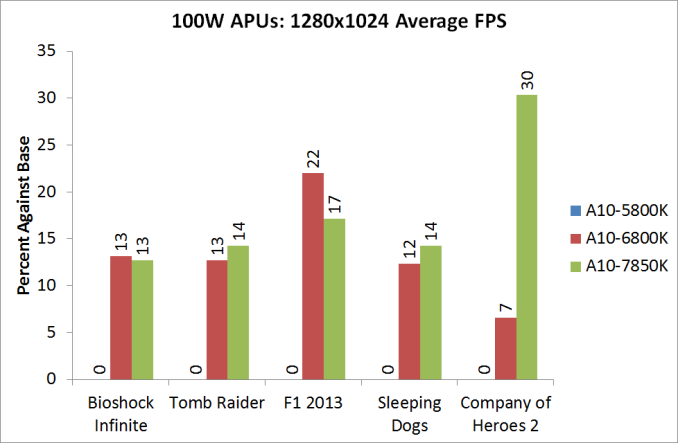
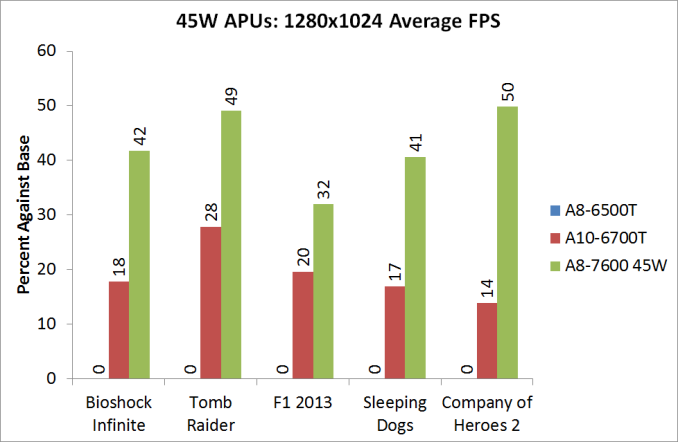
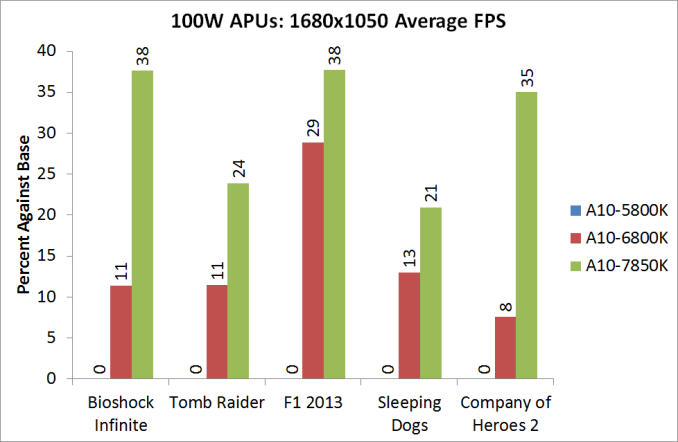
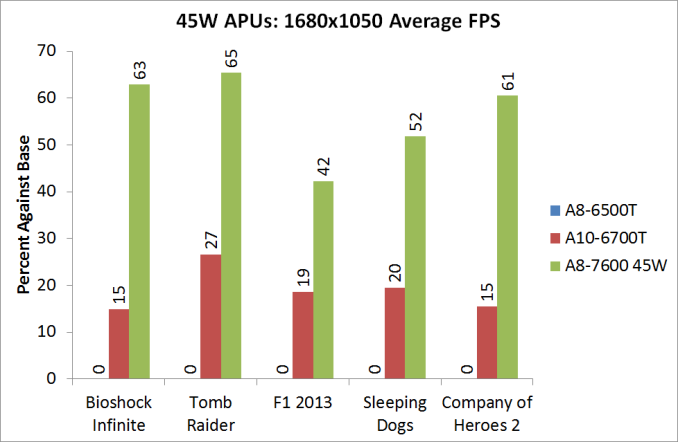
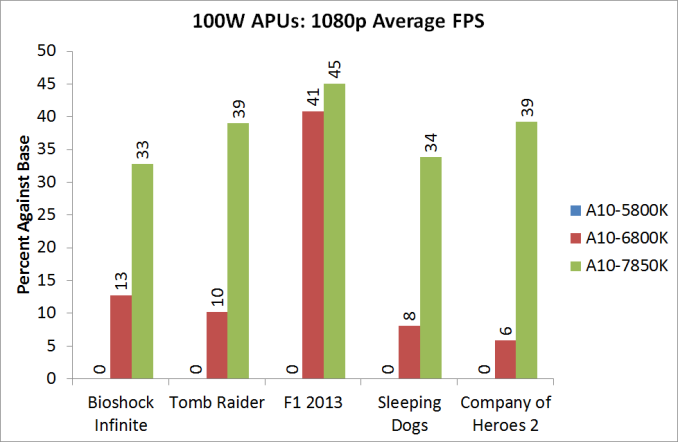

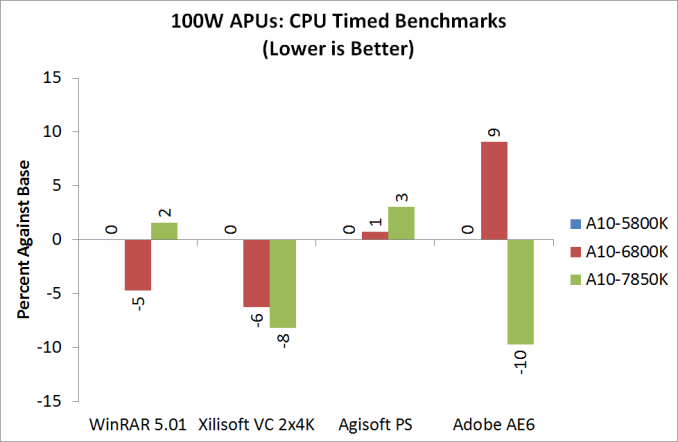
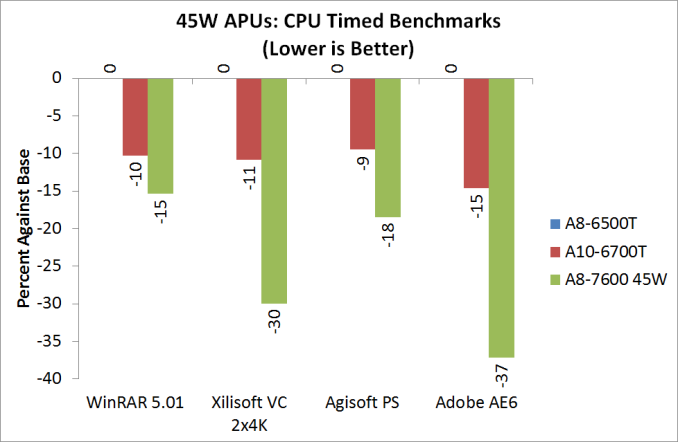

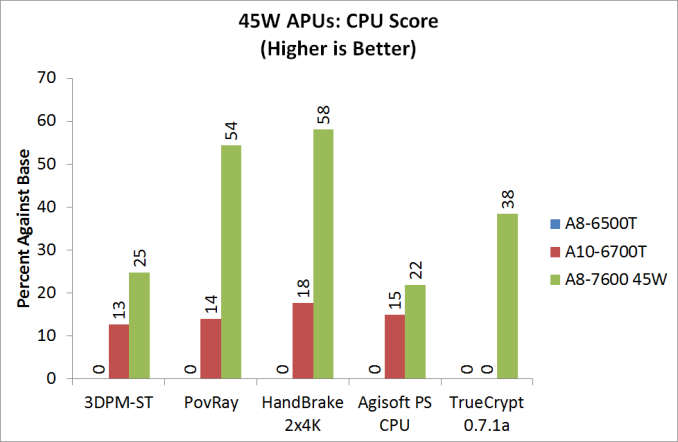
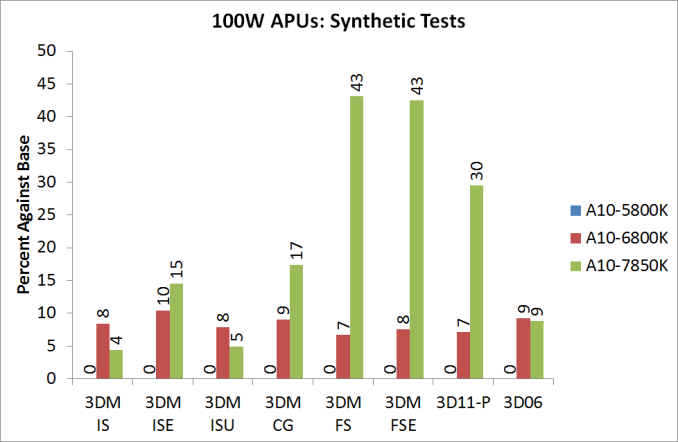
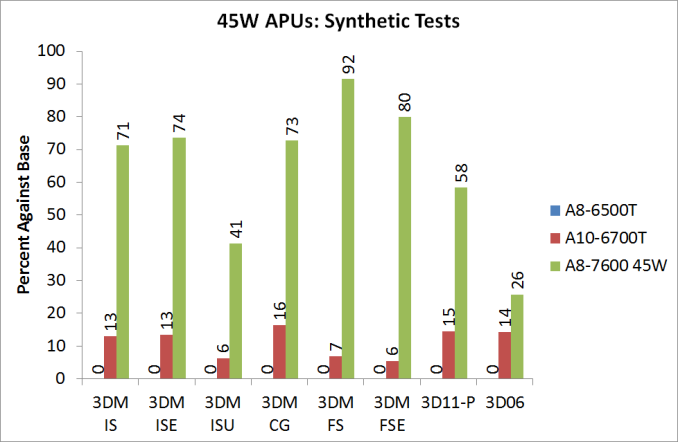
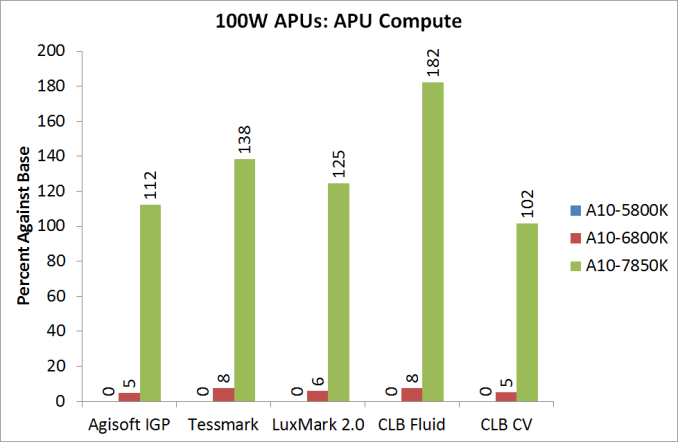

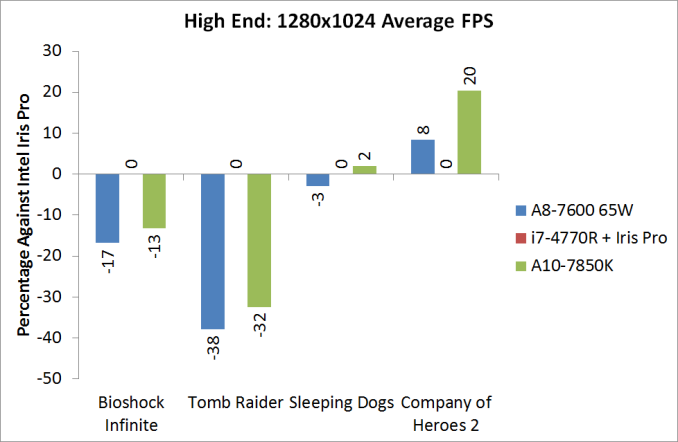
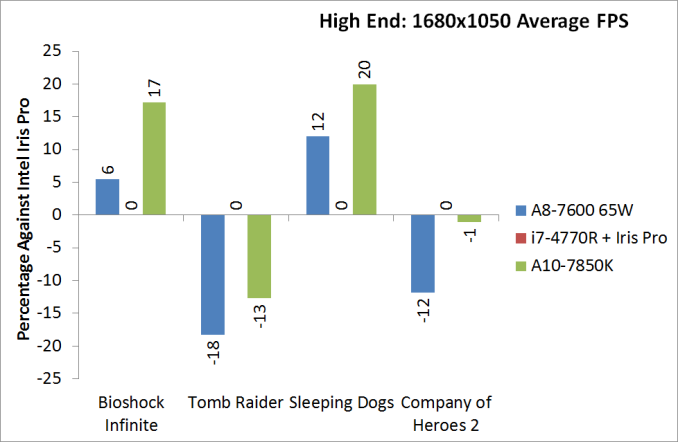
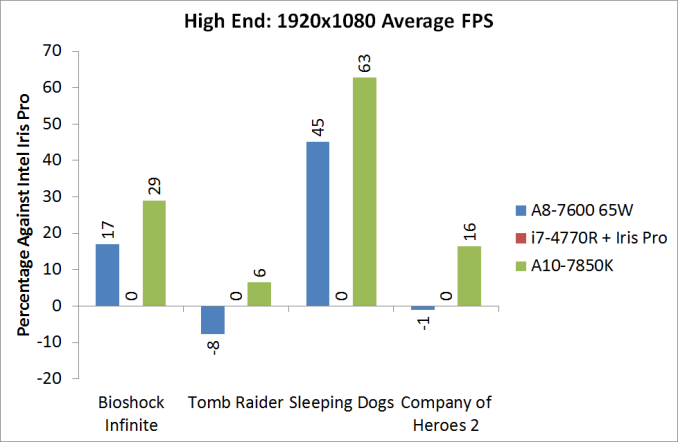








380 Comments
View All Comments
eanazag - Wednesday, January 15, 2014 - link
In reference to the no FX versions, I don't think that will change. I think we are stuck with it indefinitely. From the AMD server roadmap and info in this article related to process, I believe that the Warsaw procs will be a die shrink to 12/16 because the GF 28nm process doesn't help clocks. The current clocks on the 12/16 procs already suck so they might stay the same or better because of the TDP reduction at that core count, but it doesn't benefit in the 8 core or less pile driver series. Since AMD has needed to drive CPU clock way higher to compensate for a lack of IPC and the 28 nm process hurts clocks, I am expecting to not see anything for FX at all. Only thing that could change that is if a process at other than GF would make a good fit for a die shrink. I still doubt they will be doing any more changes to the FX series at the high end.So to me, this might force me to consider only Intel for my next build because I am still running discrete GPUs in desktop and I want at least 8 core (AMD equivalent in Intel) performance CPUs in my main system. I will likely go with a #2 Haswell chip. I am not crazy about paying $300 for a CPU, but $200-300 is okay.
I would not be surprised to see an FX system with 2P like the original FX. The server roadmap is showing that. This would essentially be two Kaveri's and maybe crossfire between the two procs. That sounds slightly interesting if I could ratchet up the TDP for the CPU. It does sound like a Bitcoin beast.
britjh22 - Wednesday, January 15, 2014 - link
I think there are some interesting points to be made about Kaveri, but I think the benchmarks really fall short of pointing to some possibly interesting data. Some of the things I got from this:1. The 7850k is too expensive for the performance it currently offers (no proliferation of HSA), and the people comparing it to cheaper CPU/dGPU are correct. However to say Kaveri fails based on that particular price comparison is a failure to see what else is here, and the article does point that out somewhat.
2. The 45W part does seem to be the best spot at the moment for price to performance, possibly indicating that more iGPU resources don't give up much benefit without onboard cache like crystalwell/Iris Pro. However, putting the 4770R in amongst the benches is no super useful due to the price and lack of availability, not to mention it not being socketed.
3. The gaming benchmarks may be the standard for AT, but they really don't do an effective job to either prove or disprove AMD's claims for gaming performance. Plenty of people will (and have looking at the comments) say they have failed at 1080p gaming scores based on 1080p extreme settings. Even some casual experimentation to see what is actually achievable at 1080p would be helpful and informative.
4. I think the main target for these systems isn't really being addressed by the review, which may be difficult to do in a score/objective way, but I think it would be useful. I think of systems like this, and more based off the 65W/45W parts as great mainstream parts. For that price ($100-130ish) you would be looking at an i3 with iGP, or a lower feature pentium part with a low end dGPU. I think at this level you get a lot more from your money with AMD. You have a system which one aspect will not become inadequate before the other (CPU vs GPU), how many relatives do we know where they have an older computer with enough CPU grunt, but not enough GPU grunt. I've seen quite a few where the Intel integrated was just good enough at the time of launch, but a few years down the road would need a dGPU or more major system upgrade. A system with the A8-7600 would be well rounded for a long time, and down the road could add a mid grade dGPU for good gaming performance. I believe it was an article on here that recently showed even just an A8 was quite sufficient for high detail 1080p when paired with a mid to high range card.
5. As was referenced another review and in the comments, a large chunk of steam users are currently being served by iGPU's which are worse then this. These are the people who play MMO's, free to play games, source games, gMod games, DOTA2/LoL, indie games, and things like Hearthstone. For them, and most users that these should be aimed at, the A10-7850K (at current pricing) is not a winner, and they would probably be better (value) or equally (performance) served by the A8-7600. This is a problem with review sites, including AT, which tend to really look at the high end of the market. This is because the readership (myself included) is interested for personal decision making, and the manufacturer's provide these products as, performance wise, they are the most flattering. However, I think some of the most interesting and prolific advances are happening in the middle market. The review does a good job of pointing that out with the performance charts at 45W, however I think some exploration into what was mentioned in point #3 would really help to flesh this out. Anand's evaluation for CPU advances slowing down in his Mac Pro is a great example of this, and really points out how HSA could be a major advancement. I upgraded from a Q6600 to a 3570K, and don't see any reasons coming up to make a change any time soon, CPU's have really become somewhat stagnant at the high end of performance. Hopefully AMD's gains at the 45W level can pan out into some great APU's in laptops for AMD, for all the users for games like the above mentioned.
fteoath64 - Sunday, January 19, 2014 - link
As consumers, our problem with the prices inching upwards in the mid-range is that Intel is not supplying enough models of the i3 range within the price point of AMD APU (mid to highest models). This means the prices are well segmented in the market such that they will not change giving excuse for slight increases as we have seen with Richland parts. It seems like lack of competition in the segment ranges indicate a cartel like behaviour in the x86 market.AMD is providing the best deal in a per transistor basis while consumers expects their cpu performance to ran on par with Intel. That is not going to happen as Intel's gpu inprovement inches closer to AMD. With HSA, the tables have turned for AMD and Intel with Nvidia certain will have to respond some time in the future. This is come when the software changes for HSA makes a significant improvement in overall performance for AMD APUs. We shall see but I am hopeful.
woogitboogity - Wednesday, January 15, 2014 - link
Ah AMD... to think that in the day of thunderbird they were once the under-appreciated underdog where the performance was. The rebel against the P4 and it's unbelievably impractical pipeline architecture.Bottom line is Intel still needs them as anti-trust suit insurance... with this SoC finally getting off the ground is anyone else wondering whether Intel was less aggressive with their own SoC stuff as a "AMD doggy/gimp treat"? Still nice to able to recommend a processor without worrying about the onboard graphics when they are on chip.
Hrel - Wednesday, January 15, 2014 - link
"do any AnandTech readers have an interest in an even higher end APU with substantially more graphics horsepower? Memory bandwidth obviously becomes an issue, but the real question is how valuable an Xbox One/PS4-like APU would be to the community."I think as a low end Steam Box that'd be GREAT! I'm not sure the approach Valve is looking to take with steam boxes, but if there's no "build your own" option then it doesn't make sense to sell it to us. Makes a lot more sense for them to do that and just sell the entire "console" directly to consumers. Or, through a reseller, but then I become concerned with additional markup from middlemen.
tanishalfelven - Wednesday, January 15, 2014 - link
You can install steamos on whatever computer you want... even one you built your self or one you already own. I'd personally think a pc based on something like this processor would be significantly less expensive (i can imagine 300 bucks) and maybe even faster. And more importantly with things like humble bundle it'd be much much cheaper in the games department...tanishalfelven - Wednesday, January 15, 2014 - link
i am wrong on faster than ps4 however, point standsJBVertexx - Wednesday, January 15, 2014 - link
As always, very good writeup, although I must confess that it took me a few attempts to get thru the HSA feel dive! Still, it was a much needed education, so I appreciate that.I have had to digest this, as I was initially really dissappointed at the lack of progress on the CPU front, but after reading through all the writeups I could find, I thinks the real story here is about the A8-7600 and opening up new markets for advanced PC based gaming.
If you think about it, that is where the incentive is for game developers to develop for Mantle. Providing the capability for someone who already has or would purchase an advanced discrete GPU to play with equal performance on an APU provides zero economic incentive for game developers.
However, if AMD can successfully open up as advanced gaming to the mass, low cost PC market, even if that performance is substandard by "enthudiast" standards, then that does provide huge economic incentive for developers, because the cost of entry to play your game has just gone down significantly, potentially opening up a vast new customer base.
With Steam really picking up "steam", with the consoles on PC tech, and with the innovative thinking going on at AMD, I have come around to thinking this is all really good stuff for PC gaming. And it's really the only path to adoption that AMD can take. I for one am hoping they're successful.
captianpicard - Wednesday, January 15, 2014 - link
I doubt Kaveri was ever intended for us, the enthusiast community. The people whom Kaveri was intended for are not the type that would read a dozen CPU/GPU reviews and then log on to newegg to price out an optimal FPS/$ rig. Instead, they would be more inclined to buy reasonably priced prebuilt PCs with the hope that they'd be able to do some light gaming in addition to the primary tasks of web browsing, checking email, watching videos on youtube/netflix, running office, etc.Nothing really up till now has actually fulfilled that niche, and done it well, IMO. Lots of machines from dell, HP, etc. have vast CPU power but horrendous GPU performance. Kaveri offers a balanced solution at an affordable price, in a small footprint. So you could put it into a laptop or a smart tv or all in one pc and be able to get decent gaming performance. Relatively speaking, of course.
izmanq - Wednesday, January 15, 2014 - link
why put i7 4770 with discrete HD 6750 in the integrated GPU performance charts ? :|